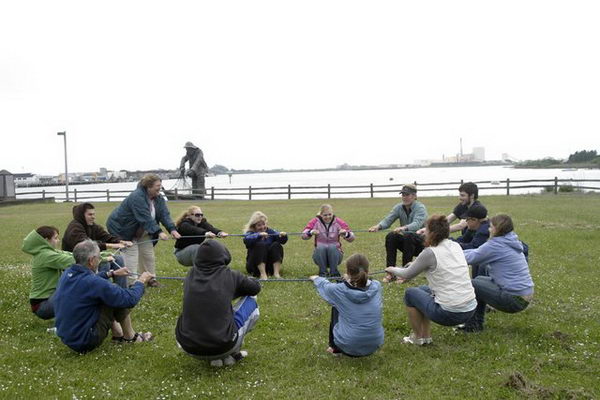Objective: participants work together to move entire group
across simulated “lava river”
Emphasis
·
Develop cohesion and teamwork
·
Enhance communication skills
·
Stimulate care and concern for others through
individual and group responsibility
·
Identify or improve leadership potential
·
Establish support systems
Materials
·
A large open area, a hallway or gymnasium floor
·
One block, brick or rock for each participant
(various sizes of cut 2”x4” work very well. Pick up scrap lumber, different
shaped wood from a construction site or a piece of paper if you are really low on budget/time)
Instructions
·
Mark a start and finish line on the field
·
Give each participant one block. Explain the
only place a team member can step is on the blocks
·
Team members lay down the blocks one at a time in
a line toward the finish point, with team members standing on the blocks. It
will be necessary to share blocks in order that an extra block is made
available
·
Pass the extra block to the front team member
who places it on the ground in front of him
·
Repeat this process until all have crossed the
“lava river”
Variations
·
Have each member choose a block that represents
them. then allow each member to share with the group the attributes that the
block possesses that are similar to the individual. Do not give any
instructions as to how to complete the task. Remind them the block represents
themselves and others and they need to learn and practice using themselves and
others as a support system
·
Teach social responsibility by establishing the
rule that if one team member steps off the blocks or has some other miscue
where the floor is touched, the entire team must return to the beginning to
start the exercise again
·
Divide large groups into competing teams and
challenge each other to the finish line, or race against set time
·
Give an extra block to the group, or take one
block away
·
Blindfold a member of the group to increase care
and responsibility for one another
·
Individuals must step on the blocks and not
skate across the area on them
·
Do not give specific instructions, but tell
group to figure out possibilities
The group must get everyone through an electric tunnel. No
one can touch any of the interior or exterior sides of the tunnel or anything
that is touching those sides. The group is provided with some “insulated
blocks.” Location should be any open area where a tunnel can be improvised out
of boxes, etc. or an area where a tunnel area
Image credit: https://blogger.googleusercontent.com/img/b/R29vZ2xl/AVvXsEi1O1D-3RK-FCODUOUGrWnSDhDGxzyAiY3WvVV8MLp8KthusIvKK93UaXPNmnHuMupkhxG43d4ucf6RkvPMKuLXzmCXsZd6I7MDH7f6Jid5TD3mEZVhiIY1PobBqmxLSFBn2AJCLnXE3yE/s1600/IMG_3220.JPG










